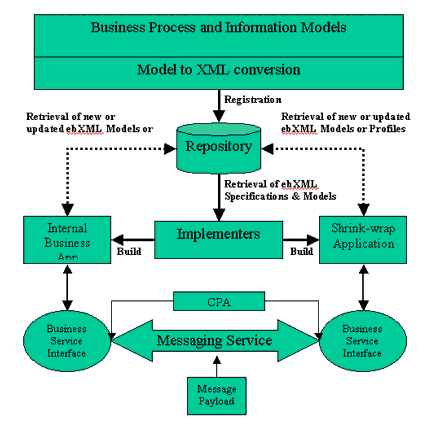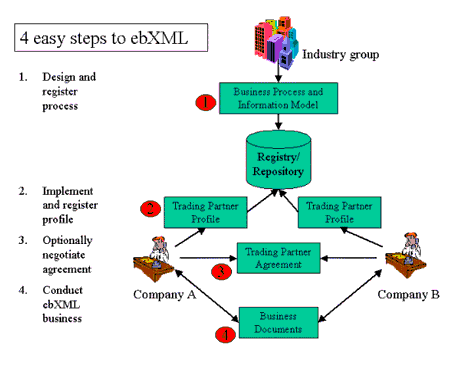| ebXML
WHITEPAPERS |
Enabling Electronic Business with ebXML
December 2000
|
|
ebXML Initiative
The vision of ebXML is to create a single global electronic marketplace where
enterprises of any size and in any geographical location can meet and conduct
business with each other through the exchange of XML based messages. ebXML enables
anyone, anywhere, to do business with anyone else over the internet.
ebXML is a set of specifications that together enable a modular, yet complete
electronic business framework. If the Internet is the information highway for
electronic business, then ebXML can be thought of as providing the on ramps, off
ramps, and the rules of the road.
The ebXML architecture provides:
- A way to define business processes and their associated messages and content.
- A way to register and discover business process sequences with related message
exchanges.
- A way to define company profiles.
- A way to define trading partner agreements.
- A uniform message transport layer.
The ebXML initiative is designed for electronic interoperability, allowing
businesses to find each other, agree to become trading partners and conduct business.
All of these operations can be performed automatically, minimizing, and in most
cases completely eliminating the need for human intervention. This streamlines
electronic business through a low cost, open, standard mechanism.
ebXML is global in support, scope and implementation. It is a joint
initiative of the United Nations (UN/CEFACT) and OASIS, developed with global
participation for global usage. Membership in ebXML is open to anyone and the
initiative enjoys broad industry support with over 75 member companies, and in
excess of 2,000 participants drawn from over 30 countries. Participants represent
major vendors and users in the IT industry and leading vertical and horizontal
industry associations.
ebXML is evolutionary, not revolutionary. It is based on Internet technologies
using proven, public standards such as: HTTP, TCP/IP, mime, smtp, ftp, UML, and
XML. The use of public standards yields a simple and inexpensive solution that
is open and vendor-neutral. ebXML can be implemented and deployed on just about
any computing platform and programming language.
Electronic commerce is not a new concept. For the past 25 years, companies
have been exchanging information with each other electronically, based on Electronic
Data Interchange (EDI) standards. Unfortunately, EDI currently requires significant
technical expertise, and deploys tightly coupled, inflexible architectures. While
it is possible to deploy EDI applications on public networks, they are most often
deployed on expensive dedicated networks to conduct business with each other.
As a result, EDI adoption has been limited to primarily large enterprises and
selected trading partners, which represents a small fraction of the world's business
entities. By leveraging the efforts of technical and business experts, and applying
today's best practices, ebXML aims to remove these obstacles. This opens the possibility
of low cost electronic business to virtually anyone with a computer and an application
that is capable of reading and writing ebXML messages. Businesses of all sizes
will adopt ebXML for reasons of lower development cost, flexibility, and ease
of use.
ebXML is now. Although the complete set of ebXML specifications will
be finished by May 2001, developers can begin working with ebXML now. The Messaging
Service, Registry & Repository, and Collaberative Partner Agreement, comprise
the core ebXML infrastructure specifications. The Messaging Service specification
has gone through several drafts and proof of concept demonstrations and is stable
enough to be used for early development work. Work is continuing on the Registry
& Repository and Collaborative Partner specifications, with final approved
specifications expected by March 2001.
ebXML is an end-to-end solution, but it is modular in nature. Businesses are
not required to implement the entire specification all at once. Specification
sets may be implemented incrementally as needed. The specification sets, each
being stand-alone, but all of them being aligned with each other, can be implemented
individually or in a number of useful combinations.
As the world adopts ebXML, barriers to participation in global electronic business
will fall away. Virtually free transport will be available over the Internet.
Standards-based business process and message definitions will drastically reduce
the cost of negotiating trading partner agreements. ebXML compliant off-the-shelf
software will enable any company, however low-tech, to easily implement their
participation in ebXML-based electronic business.
The ebXML enabled world is one of mixed, small, medium- and large-sized enterprises
conducting business with each other in much more standard and low cost ways than
today. Numerous opportunities will exist for all businesses to move to new, innovative,
service based business models, without having to fundamentally change existing
architectures or software.
Architectural overview
In order for enterprises to conduct electronic business with each other they
must:
- Discover each other and the products and services they have to offer.
- Determine which shared business processes, and associated document exchanges,
to use for obtaining products or services from each other.
- Determine the contact points and form of communication for the exchange of
information.
- Agree on the contractual terms on the above chosen processes and associated
information.
And then they can:
- Exchange information and services in an automated fashion in accordance with
these agreements.
ebXML is designed to meet these needs and is built on three basic concepts:
provide an infrastructure that ensures data communication interoperability; provide
a semantics framework that ensures commercial interoperability; and provide a
mechanism that allows enterprises to find each other, agree to become trading
partners and conduct business with each other.
- Infrastructure to ensure data communication interoperability is provided through:
- a standard message transport mechanism with a well defined interface, packaging
rules, and a predictable delivery and security model
- a 'business service interface' that handles incoming and outgoing messages
at either end of the transport
- Semantic Framework to ensure commercial interoperability is provided through:
- metamodel for defining business process and information models
- set of re-useable business logic based on core components that reflect common
business processes and XML vocabularies
- process for defining actual message structures and definitions as they relate
to the activities in the Business Process model.
- Mechanism to allow enterprises to find each other, agree to establish business
relationships,and conduct business, is provided through:
- shared repository where enterprises can register and discover each other's
business services via partner profile information
- process for defining and agreeing to a formal Collaboration Protocol Agreement
(CPA), if so desired or where required.
- shared repository for company profiles, business process models and related
message structures.
ebXML Technical Architecture

The technical architecture is composed of five main area of emphasis:
- Business Process and Information Model
- Company Profiles
- Messaging Services
- Registry & Repository
- Collaberative Partner Agreements
The Business Process models define how business processes are described. Business
Processes represent the "verbs" of electronic business and can be represented
using modeling tools. The specification for business process definition enables
an organization to express its business processes so that they are understandable
by other organizations. This enables the integration of business processes within
a company, or between companies.
The Information models define reusable components that can be applied in a
standard way within a business context. These Core Components represent the "nouns
and adjectives" of electronic business. They are defined using identity items
that are common across all businesses. This enables users to define data that
is meaningful to their business while also maintaining interoperability with other
business applications.
The ebXML Messaging Service specification defines the set of services and protocols
that enables electronic business applications to exchange data. The specification
allows any application-level protocol to be used. These can include common protocols
such as SMTP, HTTP, and FTP. Well established cryptographic techniques can be
used to implement strong security. For example, secure protocols such as HTTPS
can be used to guarantee confidentiality. In addition, digital signatures can
be applied to individual messages or a group of related messages to guarantee
authenticity.
The Registry and Repository provides a number of key functions. For the user
(application) it stores company profiles and Trading Partner specifications. These
give access to specific business processes and information models to allow updates
and additions over time.For the application developer it will store not only the
final business process definitions, but also a library of core components.
The Collaborative Partner Agreement defines the technical parameters of the
Collaborative Partner Profiles (CPP) and Collaborative Partner Agreements (CPA).
This captures critical information for communications between applications and
business processes and also records specific technical parameters for conducting
electronic business.
Usage Example
Conducting electronic business with ebXML is essentially a four step process,
as illustrated in the example below. There are many different scenarios in which
these activities may be performed in slightly different sequences and with different
scope and focus.
- Design and register business processes and information models
- The implementer browses the repository for appropriate business processes,
or for the process the intended partner is registered to support
- Implement business service interfaces and register Collaborative Partner Profiles
- The implementer buys, builds, or configures application(s) capable of participating
in the selected business process.
- The implementer registers his (software's) capability to participate, in the
form of a Collaborative Partner Profile.
- Optionally negotiate and define a Collaberative Partner Agreement (CPA)
- The two parties negotiate technical details and/or functional overrides, and
draw up the result in the form of a CPA
- Parties optionally register the CPA
- Exchanging messages between business partners.
- The parties (software) send and receive ebXML messages containing ebXML business
documents, over the secure and reliable ebXML Messaging Service.
Summary
The vision of ebXML is to create a single global electronic marketplace where
enterprises of any size and in any geographical location can meet and conduct
business with each other through the exchange of XML based messages. ebXML enables
anyone, anywhere, to do business with anyone else over the internet.
ebXML is a complete set of specifications to enable secure, global, electronic
business using proven, open standards such as TCP/IP, HTTP, and XML. ebXML is
also evolutionary in nature, built on 25 years of EDI experience, designed to
work with existing EDI solutions, or be used to develop an emerging class of internet
based electronic business applications based on XML.
Since systems integration and software interoperability are the cornerstones
of any successful IT infrastructure, ebXML is built on an infrastructure that
ensures electronic interoperability. This is accomplished by providing an open
semantics framework that allows enterprises to find each other, agree to become
trading partners, and conduct business. The evolution of many new business models
will be enabled by ebXML, through business process patterns and the'commoditization'
of such business processes.
The electronic business infrastructure provided by ebXML is broad in scope
and well integrated, providing the best alternative in the industry today. And
perhaps most importantly, ebXML is platform and vendor neutral, providing an industry
solution based on open standards, designed through a collaborative and open process.

|




